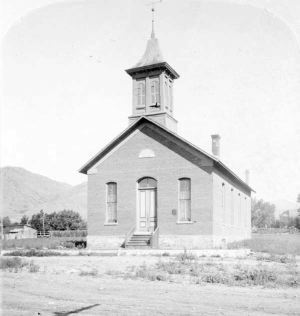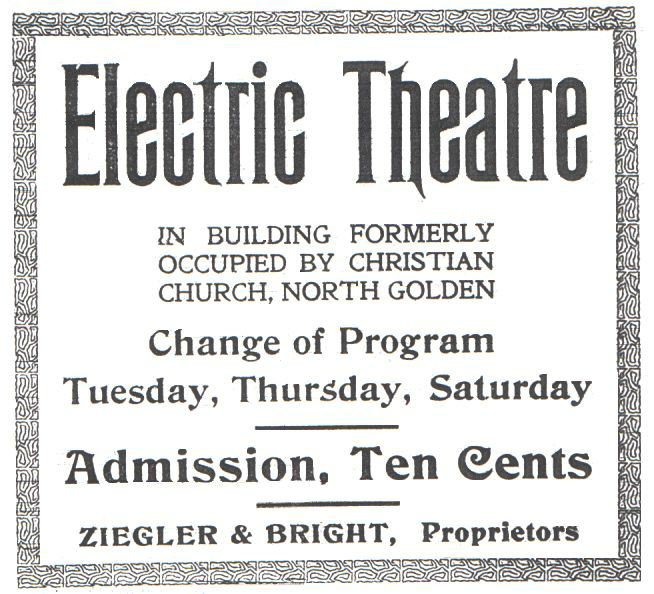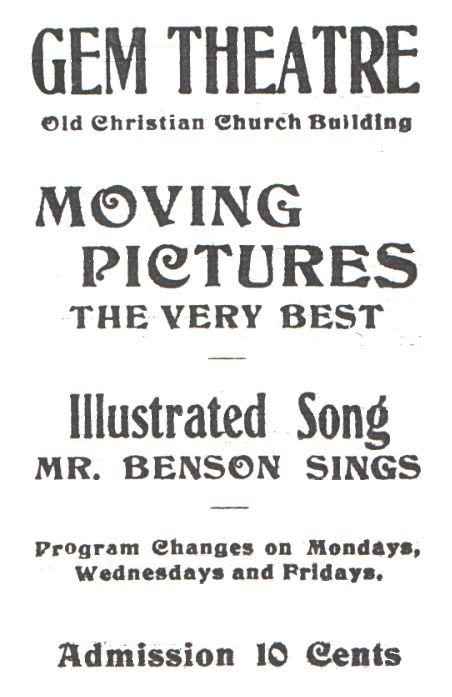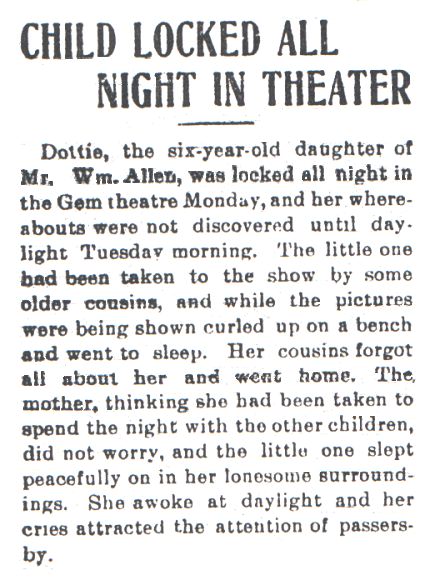
The First Christian Church, original home of the theater (stood 1873-1922) Photo courtesy Denver Public Library, Western History Department
At the dawn of a new century in Golden a new form of entertainment was taking the community by storm. The motion picture had arrived, and companies that made it were already finding the Golden valley an excellent place to film in the new medium. All Golden needed was a place to show what people were commonly starting to call “movies”.

1st Electric Theatre advertisement, Colorado Transcript 1908
Golden’s opportunity came in 1908 when two businessmen from Iowa City, Iowa, E. Bright and V. Ziegler, arrived and quickly noticed the opportunity to set up a movie house for the people. They leased the old First Christian Church, then standing at today’s location of the northwest corner of 10th and Jackson. On September 10 the Electric Theatre opened for business. Charging 10 cents admission, the Electric packed the seats with shows of short movies and illustrated songs. The program changed 3 times a week, keeping the Electric exciting and fresh. Unfortunately, the proprietors were unexpectedly called east with urgent business, and they were compelled to return to Iowa. Golden’s first movie theater was mothballed.

1st Gem Theatre advertisement, Colorado Transcript 1908
Immediately the theater drew interest from Denver parties wanting to build on its success. By October, Will I. Benson and Robert Wallschmidt, forming the Gem Motion Picture Company, had taken hold of the enterprise, and gave it a new name, the Gem Theatre. On October 12th the doors opened once again, with new quality films and illustrated songs sung by Benson or his wife. The Gem packed the house night after night, showing locally-shot films like “The Bandit King”, “The Spanish Girl”, “The Best Man Wins”, “Judgment”, and some of the earliest nationwide distributions. Many of the local films were directed by and starred Gilbert M. “Broncho Billy” Anderson, considered by many to be the father of the movie cowboy and the first western movie star. Pioneering film companies including Edison, Essanay, Selig, Reliance, Biograph and Vitagraph had films shown at the Gem.

From the front page of the Colorado Transcript, 5/13/1909
The Gem was from the beginning a steadfast supporter of the community, from fundraiser nights for the Golden Reds baseball team to high school nights for area young people. Despite the early age of film the Gem’s showings were not without special effects. On the evening of August 17, 1909, lightning hit the theater, knocked out the lights and shocked all the patrons inside. That year the proprietors renovated the building and added opera chairs for patrons to watch from, and in 1910 the Gem added a 5-piece orchestra to accompany the films. Wallschmidt, Benson’s brother-in-law, sold his interest to onetime City Councilman Walter R. Sweetser, who in 1910 sold to Oscar Williams.
The Gem battled strong competition from the Golden Theatre, run by the Cinematograph Amusement Company, which had opened in the Loveland Block (1122 Washington Ave.) in southern downtown in 1908, shortly after the reopening of the Gem. It went well until the Moehller Bros. threw their co-owner Carlton M. Hedrick in jail for embezzlement early in 1909 (his conviction was later thrown out on appeal). Gus and I. Dover, recently from Kansas, teamed with J. Ketchem, and they moved the Golden to the Merkle Building (1110 Washington Ave.), installing Golden’s first slanted floor movie venue. However, Golden’s movie house jinx was still on, starting when a brief-lived third movie theater closed because it charged Denver prices, and next when the Golden’s Dovers threw out Ketchem upon claims he tried to catch them for $300. Building owner Theodore Merkle moved to repossess the Golden and former managers Piatt and Wiard moved the theater to the ballroom of the long-vacant Belle Vista Hotel at the northwest corner of 12th and Jackson. Soon the reborn Star Theatre was giving the Gem a run for its money again.

Belle Vista Hotel (1881-1920), 2nd home of the Gem and 3rd home of the Star theaters
Theater auditorium in right 1/3rd of the main floor
From the Golden Globe Industrial Edition, 5/15/1893
1911 was a momentous year in Golden’s theater industry. Early on the Star shut down, and the Gem took its spacious place in the Belle Vista, a 25 x 140 foot auditorium with 400 seats. Benson and Williams were just getting warmed up; back at the Gem’s former home they helped organize the Golden Athletic Club. This venue for “good clean amusement” became a wild success offering workouts, dancing, boxing and basketball to members who subscribed for 50 cents a month. All this gained the attention of Walter E. Seig, who had earlier acted in some of the films the Gem had shown. He was contemplating building a new building at the southeast corner of 13th and Washington. Together the men charted a giant leap forward for the future of Golden entertainment.
